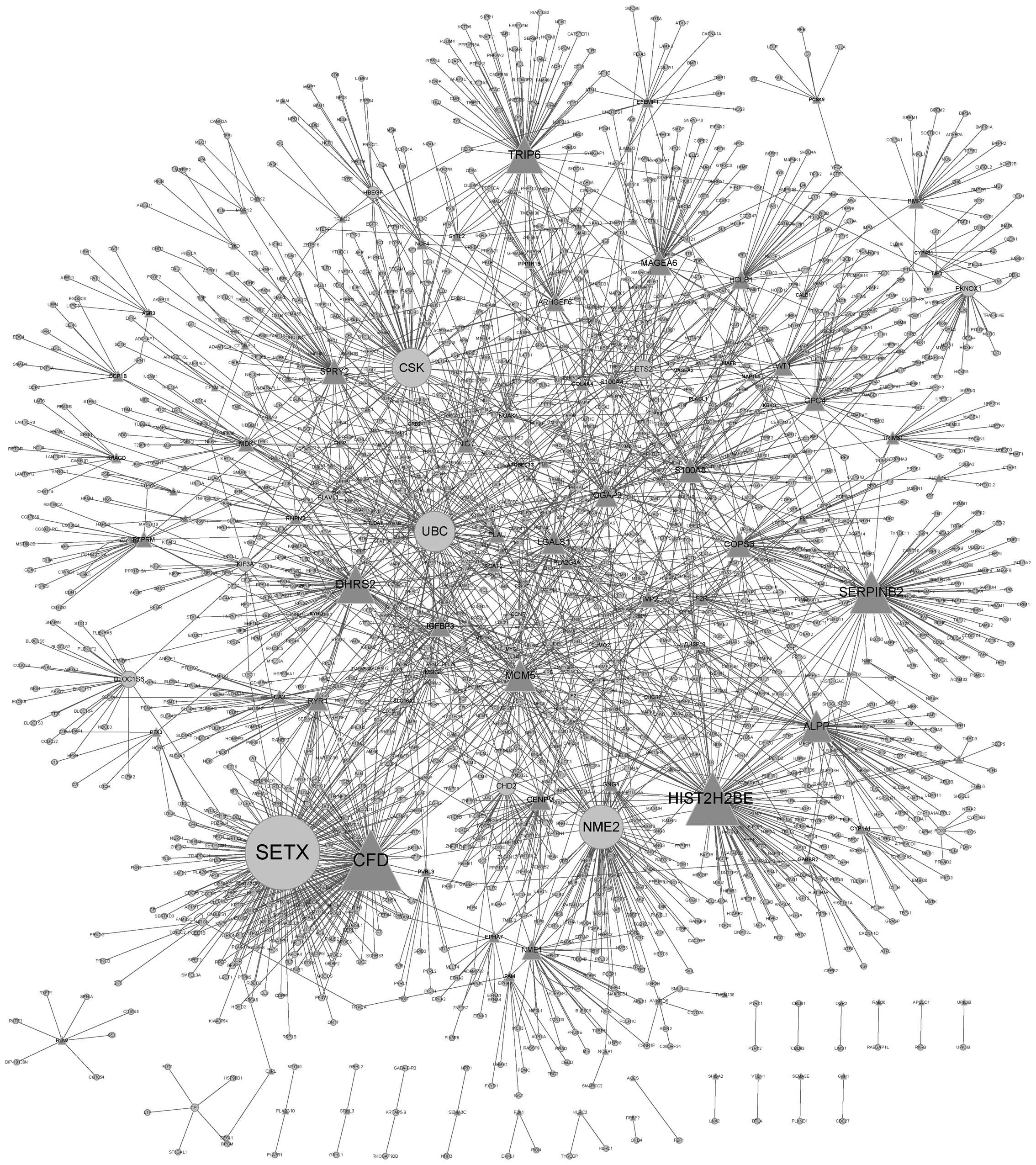|
1
|
Bryan RT: Update on bladder cancer
diagnosis and management. Trends in Urology and Men's Health.
4:7–11. 2013.
|
|
2
|
Ploeg M, Aben KK and Kiemeney LA: The
present and future burden of urinary bladder cancer in the world.
World J Urol. 27:289–293. 2009. View Article : Google Scholar : PubMed/NCBI
|
|
3
|
Billerey C, Chopin D, Aubriot-Lorton MH,
et al: Frequent FGFR3 mutations in papillary non-invasive bladder
(pTa) tumors. Am J Pathol. 158:1955–1959. 2001. View Article : Google Scholar : PubMed/NCBI
|
|
4
|
Heney NM: Natural history of superficial
bladder cancer. Prognostic features and long-term disease course.
Urol Clin North Am. 19:429–433. 1992.PubMed/NCBI
|
|
5
|
Parkin DM: The global burden of urinary
bladder cancer. Scand J Urol Nephrol Suppl. 218:12–20. 2008.
View Article : Google Scholar : PubMed/NCBI
|
|
6
|
Boffetta P: Tobacco smoking and risk of
bladder cancer. Scand J Urol Nephrol Suppl. 218:45–54. 2008.
View Article : Google Scholar : PubMed/NCBI
|
|
7
|
Zeegers MP, Tan FE, Dorant E and van Den
Brandt PA: The impact of characteristics of cigarette smoking on
urinary tract cancer risk: A meta-analysis of epidemiologic
studies. Cancer. 89:630–639. 2000. View Article : Google Scholar : PubMed/NCBI
|
|
8
|
Sánchez-Carbayo M and Cordon-Cardó C:
Molecular alterations associated with bladder cancer progression.
Semin Oncol. 34:75–84. 2007. View Article : Google Scholar : PubMed/NCBI
|
|
9
|
Cordon-Cardo C: Molecular alterations
associated with bladder cancer initiation and progression. Scand J
Urol Nephrol Suppl. 218:154–165. 2008. View Article : Google Scholar : PubMed/NCBI
|
|
10
|
Ornitz DM, Xu J, Colvin JS, et al:
Receptor specificity of the fibroblast growth factor family. J Biol
Chem. 271:15292–15297. 1996. View Article : Google Scholar : PubMed/NCBI
|
|
11
|
Thompson LM, Plummer S, Schalling M, et
al: A gene encoding a fibroblast growth factor receptor isolated
from the Huntington disease gene region of human chromosome 4.
Genomics. 11:1133–1142. 1991. View Article : Google Scholar : PubMed/NCBI
|
|
12
|
Perez-Castro AV, Wilson J and Altherr MR:
Genomic organization of the human fibroblast growth factor receptor
3 (FGFR3) gene and comparative sequence analysis with the mouse
Fgfr3 Gene. Genomics. 41:10–16. 1997. View Article : Google Scholar : PubMed/NCBI
|
|
13
|
Pandith AA, Shah ZA and Siddiqi MA:
Oncogenic role of fibroblast growth factor receptor 3 in
tumorigenesis of urinary bladder cancer. Urol Oncol. 31:398–406.
2013. View Article : Google Scholar : PubMed/NCBI
|
|
14
|
Turner N and Grose R: Fibroblast growth
factor signalling: From development to cancer. Nat Rev Cancer.
10:116–129. 2010. View
Article : Google Scholar : PubMed/NCBI
|
|
15
|
Passos-Bueno MR, Wilcox WR, Jabs EW,
Sertié AL, Alonso LG and Kitoh H: Clinical spectrum of fibroblast
growth factor receptor mutations. Hum Mutat. 14:115–125. 1999.
View Article : Google Scholar : PubMed/NCBI
|
|
16
|
Hernández S, de Muga S, Agell L, et al:
FGFR3 mutations in prostate cancer: association with low-grade
tumors. Mod Pathol. 22:848–856. 2009.PubMed/NCBI
|
|
17
|
Rosty C, Aubriot MH, Cappellen D, et al:
Clinical and biological characteristics of cervical neoplasias with
FGFR3 mutation. Mol Cancer. 4:152005. View Article : Google Scholar : PubMed/NCBI
|
|
18
|
Cappellen D, De Oliveira C, Ricol D, et
al: Frequent activating mutations of FGFR3 in human bladder and
cervix carcinomas. Nat Genet. 23:18–20. 1999. View Article : Google Scholar : PubMed/NCBI
|
|
19
|
Billerey C, Chopin D, Aubriot-Lorton MH,
et al: Frequent FGFR3 mutations in papillary non-invasive bladder
(pTa) tumors. Am J Pathol. 158:1955–1959. 2001. View Article : Google Scholar : PubMed/NCBI
|
|
20
|
Jebar AH, Hurst CD, Tomlinson DC, Johnston
C, Taylor CF and Knowles MA: FGFR3 and Ras gene mutations are
mutually exclusive genetic events in urothelial cell carcinoma.
Oncogene. 24:5218–5225. 2005. View Article : Google Scholar : PubMed/NCBI
|
|
21
|
Du X, Wang QR, Chan E, et al: FGFR3
stimulates stearoyl CoA desaturase 1 activity to promote bladder
tumor growth. Cancer Res. 72:5843–5855. 2012. View Article : Google Scholar : PubMed/NCBI
|
|
22
|
Tomlinson DC, Hurst CD and Knowles MA:
Knockdown by shRNA identifies S249C mutant FGFR3 as a potential
therapeutic target in bladder cancer. Oncogene. 26:5889–5899. 2007.
View Article : Google Scholar : PubMed/NCBI
|
|
23
|
Miyake M, Ishii M, Koyama N, et al:
1-tert-butyl-3-[6-(3,
5-dimethoxy-phenyl)-2-(4-diethylamino-butylamino)-pyrido [2, 3-d]
pyrimidin-7-yl]-urea (PD173074), a selective tyrosine kinase
inhibitor of fibroblast growth factor receptor-3 (FGFR3), inhibits
cell proliferation of bladder cancer carrying the FGFR3 gene
mutation along with up-regulation of p27 Kip1 and G1 G0 arrest. J
Pharmacol Exp Ther. 332:795–802. 2010. View Article : Google Scholar : PubMed/NCBI
|
|
24
|
Irizarry RA, Hobbs B, Collin F, et al:
Exploration, normalization and summaries of high density
oligonucleotide array probe level data. Biostatistics. 4:249–264.
2003. View Article : Google Scholar : PubMed/NCBI
|
|
25
|
Smyth GK: Limma: linear models for
microarray dataBioinformatics and Computational Biology Solutions
Using R and Bioconductor. Gentleman R, Carey V, Huber W, Irizarry
RA and Dudoit S: Springer; New York, NY: pp. 397–420. 2005
|
|
26
|
Benjamini Y and Hochberg Y: Controlling
the false discovery rate: A practical and powerful approach to
multiple testing. J Roy Statist Soc Ser B (Methodological).
57:289–300. 1995.
|
|
27
|
Huang da W, Sherman BT and Lempicki RA:
Systematic and integrative analysis of large gene lists using DAVID
bioinformatics resources. Nat Protoc. 4:44–57. 2009. View Article : Google Scholar : PubMed/NCBI
|
|
28
|
Cowley MJ, Pinese M, Kassahn KS, et al:
PINA v2.0: Mining interactome modules. Nucleic Acids Res.
40:(Database Issue). D862–D865. 2012. View Article : Google Scholar : PubMed/NCBI
|
|
29
|
Shannon P, Markiel A, Ozier O, et al:
Cytoscape: A software environment for integrated models of
biomolecular interaction networks. Genome Res. 13:2498–2504. 2003.
View Article : Google Scholar : PubMed/NCBI
|
|
30
|
Jansen R, Greenbaum D and Gerstein M:
Relating whole-genome expression data with protein-protein
interactions. Genome Res. 12:37–46. 2002. View Article : Google Scholar : PubMed/NCBI
|
|
31
|
Kemmeren P, van Berkum NL, Vilo J, et al:
Protein interaction verification and functional annotation by
integrated analysis of genome-scale data. Mol Cell. 9:1133–1143.
2002. View Article : Google Scholar : PubMed/NCBI
|
|
32
|
Liu BH, Yu H, Tu K, Li C, Li YX and Li YY:
DCGL: An R package for identifying differentially coexpressed genes
and links from gene expression microarray data. Bioinformatics.
26:2637–2638. 2010. View Article : Google Scholar : PubMed/NCBI
|
|
33
|
Yokoyama C, Wang X, Briggs MR, et al:
SREBP-1, a basic-helix-loop-helix-leucine zipper protein that
controls transcription of the low density lipoprotein receptor
gene. Cell. 75:187–197. 1993. View Article : Google Scholar : PubMed/NCBI
|
|
34
|
Porstmann T, Griffiths B, Chung YL, et al:
PKB Akt induces transcription of enzymes involved in cholesterol
and fatty acid biosynthesis via activation of SREBP. Oncogene.
24:6465–6481. 2005.PubMed/NCBI
|
|
35
|
Wu J, Liu J, Jia R and Song H: Nur77
inhibits androgen-induced bladder cancer growth. Cancer Invest.
31:654–660. 2013. View Article : Google Scholar : PubMed/NCBI
|
|
36
|
Degener S, Roth S, Mathers MJ and Ubrig B:
Follow-up care-consequences of urinary diversion after bladder
cancer. Urologe A. 53:253–262. 2014.(In German). View Article : Google Scholar : PubMed/NCBI
|
|
37
|
Lascu I: The nucleoside diphosphate
kinases 1973–2000. J Bioenerg Biomembr. 32:211–214. 2000.
View Article : Google Scholar
|
|
38
|
Rayner K, Chen YX, Hibbert B, et al:
Discovery of NM23-H2 as an estrogen receptor β-associated protein:
Role in estrogen-induced gene transcription and cell migration. J
Steroid Biochem Mol Biol. 108:72–81. 2008. View Article : Google Scholar : PubMed/NCBI
|
|
39
|
Steeg PS, Bevilacqua G, Kopper L, et al:
Evidence for a novel gene associated with low tumor metastatic
potential. J Natl Cancer Inst. 80:200–204. 1988. View Article : Google Scholar : PubMed/NCBI
|
|
40
|
Yong G: Expression of C-erbB-2, EGFR and
nm23-H1 in human bladder cancer and its clinical significance. Proc
Clin Med. 2011((5)): 333–365. 2011.
|
|
41
|
Cook LM, Hurst DR and Welch DR: Metastasis
suppressors and the tumor microenvironment. Semin Cancer Biol.
21:113–122. 2011. View Article : Google Scholar : PubMed/NCBI
|
|
42
|
Legin AA, Jakupec MA, Bokach NA, Tyan MR,
Kukushkin VY and Keppler BK: Guanidine platinum (II) complexes:
Synthesis, in vitro antitumor activity and DNA interactions. J
Inorg Biochem. 133:33–39. 2014. View Article : Google Scholar : PubMed/NCBI
|
|
43
|
Chen S, Su L, Qiu J, et al: Mechanistic
studies for the role of cellular nucleic-acid-binding protein
(CNBP) in regulation of c-myc transcription. Biochim Biophys Acta.
1830:4769–4777. 2013. View Article : Google Scholar : PubMed/NCBI
|
|
44
|
Poli A, Ramazzotti G, Matteucci A, et al:
A novel DAG-dependent mechanism links PKCα and Cyclin B1 regulating
cell cycle progression. Oncotarget. 30:11526–11540. 2014.
|
|
45
|
Soria JC, Jang SJ, Khuri FR, et al:
Overexpression of cyclin B1 in early-stage non-small cell lung
cancer and its clinical implication. Cancer Res. 60:4000–4004.
2000.PubMed/NCBI
|
|
46
|
Nakamura N, Yamamoto H, Yao T, et al:
Prognostic significance of expressions of cell-cycle regulatory
proteins in gastrointestinal stromal tumor and the relevance of the
risk grade. Hum Pathol. 36:828–837. 2005. View Article : Google Scholar : PubMed/NCBI
|
|
47
|
Yuan J, Krämer A, Matthess Y, et al:
Stable gene silencing of cyclin B1 in tumor cells increases
susceptibility to taxol and leads to growth arrest in vivo.
Oncogene. 25:1753–1762. 2006. View Article : Google Scholar : PubMed/NCBI
|
|
48
|
Xu Y, Ayrapetov MK, Xu C, et al: Histone
H2A.Z controls a critical chromatin remodeling step required for
DNA double-strand break repair. Mol Cell. 48:723–733. 2012.
View Article : Google Scholar : PubMed/NCBI
|
|
49
|
Meneghini MD, Wu M and Madhani HD:
Conserved histone variant H2A.Z protects euchromatin from the
ectopic spread of silent heterochromatin. Cell. 112:725–736. 2003.
View Article : Google Scholar : PubMed/NCBI
|
|
50
|
Dong L, Bard AJ, Richards WG, Nitz MD,
Theodorescu D, Bueno R and Gordon GJ: A gene expression ratio-based
diagnostic test for bladder cancer. Adv Appl Bioinform Chem.
2:17–22. 2009.PubMed/NCBI
|
















